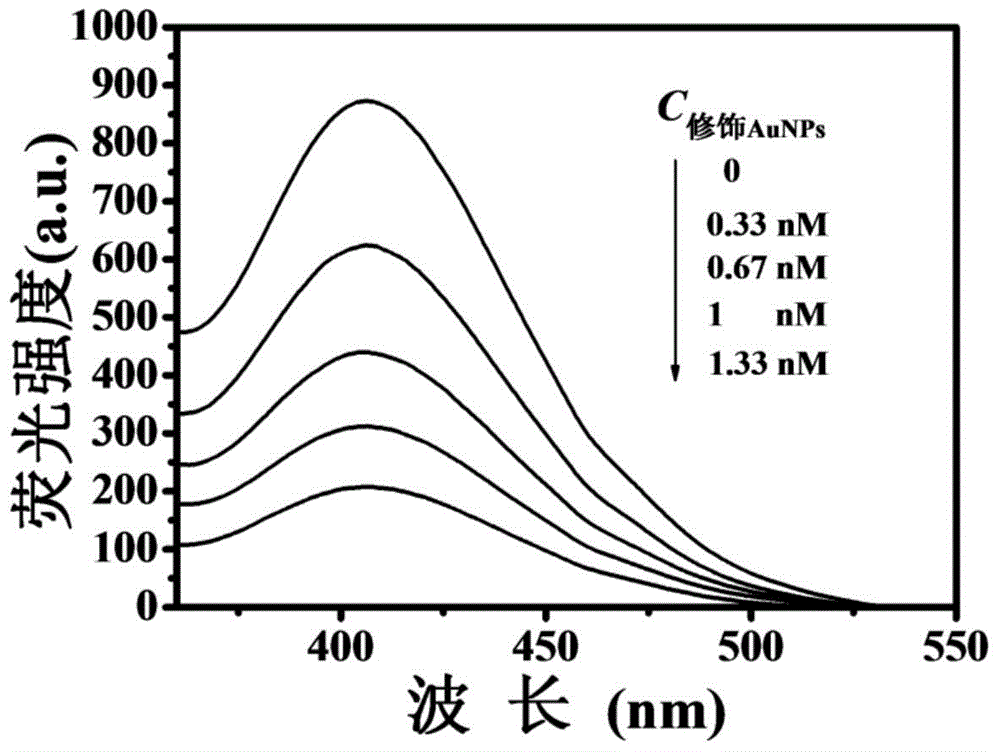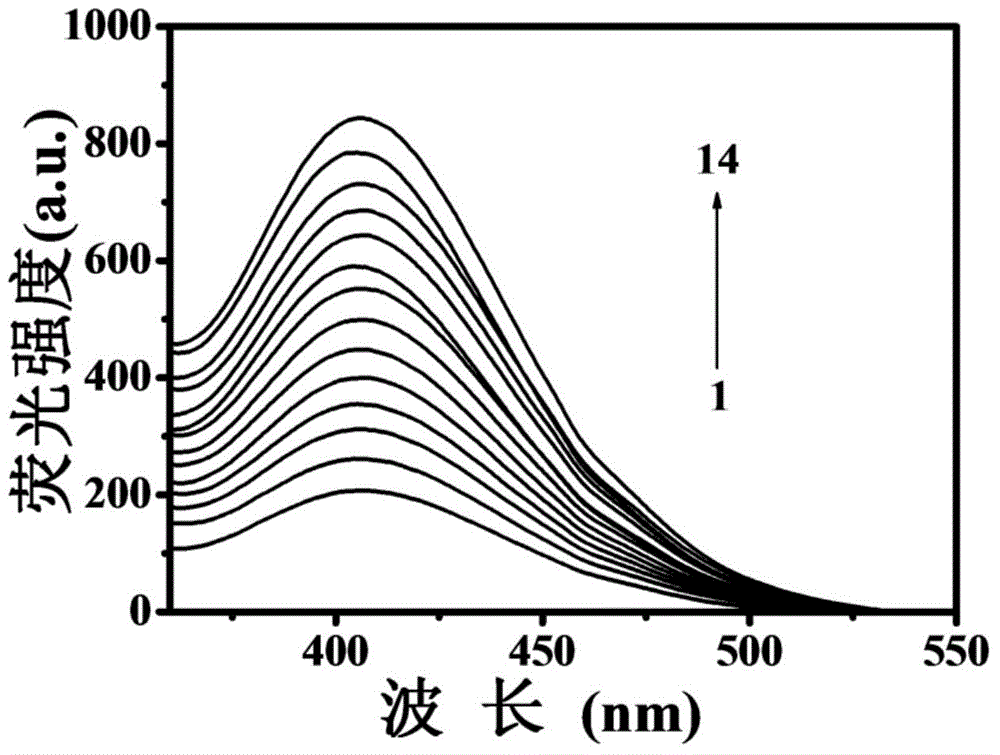Fluorescence sensor for detecting fluorine ions, and preparation method of fluorescence sensor
A fluorescent sensor and fluorine ion technology, applied in the field of analytical chemistry, can solve the problems of limited application, achieve high quantum yield, good biocompatibility and sensitivity, and simple and easy process
- Summary
- Abstract
- Description
- Claims
- Application Information
AI Technical Summary
Problems solved by technology
Method used
Image
Examples
Embodiment 1
[0054] A method for preparing a fluorescent sensor for detecting fluoride ions proposed in an embodiment of the present invention includes the following steps:
[0055] S1. Dissolve 0.08 parts by weight of 3-aminophenylboronic acid in 22 parts by weight of water, adjust the pH value of the system to 8, and then perform a hydrothermal reaction, wherein the temperature of the hydrothermal reaction is 180 ° C, and the time of the hydrothermal reaction For 8h, after the reaction is finished, carbon dots are obtained through cooling, centrifugation, and dialysis;
[0056] S2, 130 parts by volume of HAuCl with a mass fraction of 0.012% 4 The solution is heated to boiling, then 5 parts by volume of a sodium citrate solution with a mass fraction of 1.2% is added, stirred and refluxed until the system turns red, then cooled, centrifuged, and washed to obtain gold nanoparticles;
[0057] S3, after mixing 1 volume part of 3-mercapto-1,2-propanediol and 3500 volume parts of nano gold, re...
Embodiment 2
[0060] A method for preparing a fluorescent sensor for detecting fluoride ions proposed in an embodiment of the present invention includes the following steps:
[0061] S1. Dissolve 0.12 parts by weight of 3-aminophenylboronic acid in 15 parts by weight of water, adjust the pH value of the system to 10, and then perform a hydrothermal reaction, wherein the temperature of the hydrothermal reaction is 145 ° C, and the time of the hydrothermal reaction For 10h, after the reaction is completed, carbon dots are obtained through cooling, centrifugation, and dialysis;
[0062] S2, 180 parts by volume of HAuCl with a mass fraction of 0.008% 4 The solution is heated to boiling, then 6 parts by volume of 0.8% sodium citrate solution is added, stirred and refluxed until the system turns red, then cooled, centrifuged, and washed to obtain gold nanoparticles;
[0063] S3, after mixing 1 volume part of 3-mercapto-1,2-propanediol and 4500 volume parts of nano gold, reacting for 7h to obtain...
Embodiment 3
[0066] A kind of preparation method that the present invention proposes is used to detect the fluorescent sensor of fluorine ion, comprises the following steps:
[0067] S1. Dissolve 0.11g of 3-aminophenylboronic acid in 21g of water, adjust the pH of the system to 9 with 0.5mol / L sodium hydroxide solution, and then carry out a hydrothermal reaction, wherein the temperature of the hydrothermal reaction is 150°C. The time of hydrothermal reaction is 9.5h. After the reaction is finished, cool down, centrifuge, and then dialyze with a dialysis bag with a molecular weight of 800 for 28h to obtain carbon dots;
[0068] S2, 150ml mass fraction is 0.009% HAuCl 4 Heat the solution to boiling, then add 5.8ml of sodium citrate solution with a mass fraction of 0.9%, stir and reflux until the system turns red, then cool, centrifuge, and wash to obtain gold nanoparticles;
[0069] S3. Mix 3uL of 3-mercapto-1,2-propanediol and 12.6ml of gold nanoparticles and react for 8h to obtain modifie...
PUM
| Property | Measurement | Unit |
|---|---|---|
| correlation coefficient | aaaaa | aaaaa |
Abstract
Description
Claims
Application Information
 Login to View More
Login to View More - R&D
- Intellectual Property
- Life Sciences
- Materials
- Tech Scout
- Unparalleled Data Quality
- Higher Quality Content
- 60% Fewer Hallucinations
Browse by: Latest US Patents, China's latest patents, Technical Efficacy Thesaurus, Application Domain, Technology Topic, Popular Technical Reports.
© 2025 PatSnap. All rights reserved.Legal|Privacy policy|Modern Slavery Act Transparency Statement|Sitemap|About US| Contact US: help@patsnap.com



